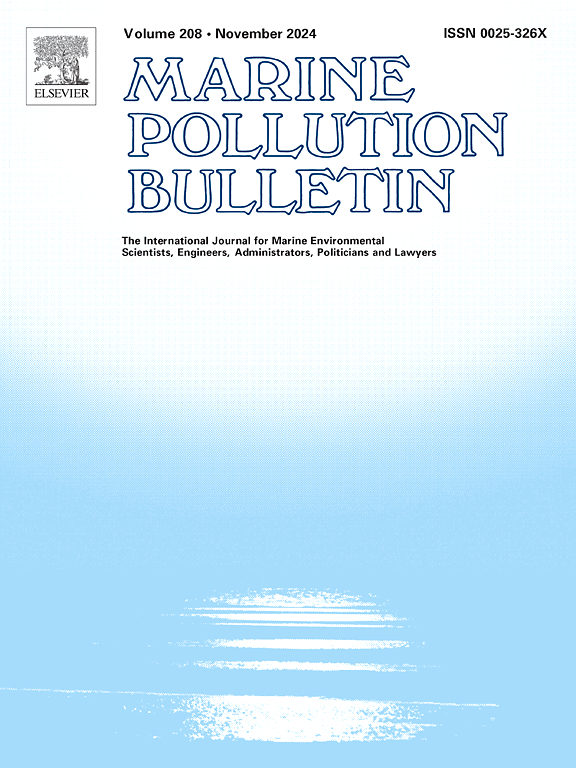Long-term water quality assessment in coastal and inland waters: An ensemble machine-learning approach using satellite data
IF 5.3
3区 环境科学与生态学
Q1 ENVIRONMENTAL SCIENCES
引用次数: 0
Abstract
Accurate estimation of coastal and in-land water quality parameters is important for managing water resources and meeting the demand of sustainable development goals. The water quality monitoring based on discrete water sample analysis is limited to specific locations and becomes less effective to offer a synoptic view of the water quality variability at different spatial and temporal scales. The optical remote sensing techniques have proved their ability to provide a comprehensive and synoptic view of water quality parameters. In conjugation with other products, the optical remote sensing data products can be utilized for the effective management of water bodies while addressing the socio-economic issues faced by local governments and states. In recent years, multiple machine-learning (ML) models have been reported on the estimation of water quality using remote sensing data, but their performance is limited when extended to diverse water types within coastal and inland water environments. In this study, we present an ensemble machine-learning model for estimating the primary water quality parameters in coastal and inland waters, such as Chlorophyll-a (Chl-a) concentration, colored dissolved organic matter (), and Turbidity. It utilizes the in-situ measurements to train and optimize the ensemble machine-learning models for the spectral measurements data (400–700 nm) provided by MODIS-Aqua, Sentinel-2 Multi Spectral Instrument (MSI), and PlanetScope (Planet). To develop the prediction models, these in-situ measurements data were split into two parts: a training dataset (70 %) and a testing dataset (30 %). The ensemble machine-learning models were validated using the 5-fold cross-validation method. These models were trained and tested against distinct datasets encompassing a broad range of variations in water quality parameters collected from open ocean, coastal and inland waters. The validation results demonstrated a superior performance of the present ensemble ML models compared to other ML models (Chl-a: R2 = 0.96, RMSE = 4.93, MAE = 2.89; : R2 = 0.93, RMSE = 0.057, MAE = 0.025; Turbidity: R2 = 0.95, RMSE = 4.52, MAE = 1.009). To realize the importance of this study, the ensemble ML models were applied to MODIS-Aqua monthly composite measurements from 2003 to 2022 and captured pronounced seasonal variations in water quality parameters (WQP) and Water Quality Index (WQI). For instance, in the Gulf of Khambhat, turbidity decreased at an annual average rate of ∼0.08 NTU and Chl-a increased at an annual average rate of ∼0.004 mg m−3 for the past 20 years. Furthermore, we investigated the occurrences of Noctiluca scintillans (here after N. scintillans) bloom between 2019 and 2021 near the fin fish cage culture sites in Mandapam, on the southeast coast of Tamil Nadu, within the Gulf of Mannar, India which serves as a documentation of the Harmful Algal Bloom (HAB) incidents. The performance of ensemble model is further demonstrated using Planet images from inland turbid waters of the Muthupet lagoon (Brackish water) and Adyar river (Urban River) and MSI image from Chilika lagoon. The proposed ensemble ML models proved as an effective method for accurately estimating the WQP and WQI products and capturing their spatial and temporal variations in regional and global waters, which forms an important tool for sustainable development and management of coastal and inland water environments.
沿海和内陆水域的长期水质评估:利用卫星数据的集合机器学习方法。
准确估算沿岸和内陆水质参数对于管理水资源和满足可持续发展目标的要求非常重要。以离散水样分析为基础的水质监测仅限于特定地点,对不同时空尺度上水质变化的综合观测效果较差。光学遥感技术已证明有能力提供全面的水质参数综合视图。光学遥感数据产品与其他产品相结合,可用于有效管理水体,同时解决地方政府和国家面临的社会经济问题。近年来,利用遥感数据估算水质的机器学习(ML)模型层出不穷,但当这些模型扩展到沿海和内陆水域环境中的不同水体类型时,其性能就受到了限制。在本研究中,我们提出了一种集合机器学习模型,用于估算沿海和内陆水域的主要水质参数,如叶绿素-a(Chl-a)浓度、有色溶解有机物(aCDOM440)和浊度。它利用现场测量数据来训练和优化由 MODIS-Aqua、哨兵-2 多光谱仪器(MSI)和 PlanetScope(Planet)提供的光谱测量数据(400-700 nm)的集合机器学习模型。为了开发预测模型,这些现场测量数据被分成两部分:训练数据集(70%)和测试数据集(30%)。使用 5 倍交叉验证法对集合机器学习模型进行验证。这些模型是根据从公海、沿海和内陆水域收集的水质参数变化范围广泛的不同数据集进行训练和测试的。验证结果表明,与其他 ML 模型相比,本集合 ML 模型性能优越(Chl-a:R2 = 0.96, RMSE = 4.93, MAE = 2.89; aCDOM440:R2=0.93,RMSE=0.057,MAE=0.025;浊度:R2=0.95,RMSE=4.52,MAE=1.009)。为了认识这项研究的重要性,将集合 ML 模型应用于 2003 年至 2022 年的 MODIS-Aqua 月度综合测量,捕捉到了水质参数(WQP)和水质指数(WQI)的明显季节性变化。例如,在过去 20 年中,坎布哈特湾的浊度以年均 ∼0.08 NTU 的速率下降,而 Chl-a 则以年均 ∼0.004 mg m-3 的速率上升。此外,我们还调查了 2019 年至 2021 年期间印度马纳尔湾泰米尔纳德邦东南海岸曼达帕姆的鳍鱼网箱养殖点附近藻华(以下简称 "藻华")的发生情况,作为有害藻华(HAB)事件的记录。利用 Muthupet 泻湖(咸水)和 Adyar 河(城市河流)内陆浑浊水域的 Planet 图像以及 Chilika 泻湖的 MSI 图像,进一步证明了集合模型的性能。事实证明,所提议的集合 ML 模型是准确估算 WQP 和 WQI 产品以及捕捉区域和全球水域空间和时间变化的有效方法,是沿海和内陆水环境可持续发展和管理的重要工具。
本文章由计算机程序翻译,如有差异,请以英文原文为准。
求助全文
约1分钟内获得全文
求助全文
来源期刊

Marine pollution bulletin
环境科学-海洋与淡水生物学
CiteScore
10.20
自引率
15.50%
发文量
1077
审稿时长
68 days
期刊介绍:
Marine Pollution Bulletin is concerned with the rational use of maritime and marine resources in estuaries, the seas and oceans, as well as with documenting marine pollution and introducing new forms of measurement and analysis. A wide range of topics are discussed as news, comment, reviews and research reports, not only on effluent disposal and pollution control, but also on the management, economic aspects and protection of the marine environment in general.
 求助内容:
求助内容: 应助结果提醒方式:
应助结果提醒方式:


